Company
Information
Service Areas
Contact Us
Showroom
Tauriko, Tauranga 3110
New Zealand
When it comes to designing a workspace, there are two distinct paths you can take — hard fitouts and soft fitouts. Modern Office has been providing creative workplace furniture solutions since 2007, and we understand what it takes to create functional, inspiring, and productive workspaces. In this blog post, we’ll explain the difference between hard and soft fitouts.
Hard fitouts involve all the construction work needed for an office space such as walls, floors, wiring, air-conditioning, and more. A hard fitout is the process of altering or refurbishing the base building that will play host to the designed space. It could be useful to think of it as the construction of the framework that an office space will inhabit, as it could include anything from re-flooring, to knocking out unnecessary or unwanted walls, to electrical work.
A hard fitout can involve changes to the physical structure of the office, such as partitioning walls, doorways, windows, or bathroom and kitchen facilities. Hard fitouts are usually required when moving into a new office or when making major changes to an existing one.
Generally speaking, these are more expensive than soft fitouts because they involve labour costs for builders and electricians as well as materials costs for things like plasterboard or tiles. They’re also longer in duration since they require more time for planning and execution.
Soft Fitouts, on the other hand, involve furnishing your workspace with items like chairs, desks, breakout furniture, and storage solutions. These are generally less expensive than hard fitouts since they don’t require any building work or labour costs. They also tend to be quicker in completion since there is no need for lengthy planning or construction timeframes. Modern Office are specialists in the soft fitout phase of a project. When you choose Modern Office for your workspace solution needs, you will receive personalised advice on furniture trends that will make sure that your commercial or office space is unique to your team’s needs while ensuring value is delivered every step of the way.
If your project involves both hard and soft fitouts, once the groundwork of the hard fitout is done, it’s time to focus on furnishings, and that’s where we come in. Having the ideal floor plan is a good and important start, which makes it easier to create a comfortable, stylish, and functional place for your team as a result. Filling your office space with furniture is an opportunity to express the character of your brand and reflect your business’ culture through aesthetics.
A high-quality soft fitout can make a substantial difference in the message a space sends and how inviting it can be. Just as a hard fitout covers more than just basic construction work, a soft fitout goes beyond office chairs and boardroom tables — depending on your needs, it could include breakout area couches, reception area furniture, artwork, and more.
So, which type of fitout is right for your business when you’re ready to make some changes? Choosing between a hard or soft fitout depends on numerous factors including budget constraints and timelines but also individual preferences. Understanding what each type entails allows business owners to make an informed decision when creating their perfect workspace solution — one that is both functional and inspiring at the same time!
If you're simply redecorating or making minor changes to your existing office space to refresh it or make it more functional for today’s employees' needs, then a soft fitout will probably suffice. However, if you're moving into a new office or making major changes to your current one, then a hard fitout will be necessary. Either way, Modern Office can help make your office design dreams a reality.
At Modern Office, we understand this process better than anyone else; having been providing creative workplace furniture solutions since 2007, we have developed a great reputation in delivering fitouts across both private and government sectors. Get in touch with us today if you would like some advice on how to create a unique workspace experience tailored specifically to your team’s needs!
As a business owner, facilities manager, or employee, you may have experienced various problems with your office. These problems can range from discomfort to low productivity to safety issues. However, did you know that office furniture can play a significant role in mitigating most of these problems? In this blog post, we'll cover the top 5 common problems you might face in your office and how office furniture can fix them.
One of the most common problems employees face is discomfort, which can lead to back pain and other issues. Uncomfortable chairs, desks that are too high or too low can cause problems for employees who are spending most of their day sitting. Investing in ergonomic furniture such as sit-stand desks, adjustable chairs, and proper lighting can help promote better posture, and reduce discomfort and back pain.

Another common issue with offices is noise pollution, which can be distracting and reduce productivity among employees. Excessive noise can come from nearby constructions, passing cars, co-workers talking, and equipment. Acoustic solutions like sound-absorbing panels, carpets, and acoustic partitions can help reduce noise levels. A quiet and peaceful office environment is crucial for employees' concentration, productivity, and overall well-being.
Open offices are the norm these days, but it can negatively affect employees’ privacy. Lack of privacy may lead to employees' inability to concentrate, reduced productivity, and potential conflicts. Thus, providing private and semi-open workstations with partition screens or panels can prevent distractions while allowing for privacy and collaboration between individuals or teams.

Cluttered offices can create a negative atmosphere, hamper productivity, and lead to accidents or injuries. Poor storage solutions, such as a lack of cabinets or stacking boxes, can contribute to this problem. Adequate storage options such as cabinets, bookshelves, and shelving units can help keep the office organised and make it easier for employees to find everything they need.
Too much equipment and furniture can take up office space, making it cramped and crowded. This lack of space can lead to safety concerns, communication issues, and reduced productivity. Choosing the right size of furniture, including desks and cabinets, and adopting an open-space concept can help optimise space in the office. It can also create a more welcoming, comfortable, and spacious office environment.

Now that you know the most common problems that occur in office environments and how office furniture can solve them, it's time to start making changes. Investing in ergonomic and comfortable office furniture, including storage units and acoustic solutions, can go a long way toward improving employee productivity, privacy, comfort, and overall well-being. Remember that a well-designed office space can reduce employee dissatisfaction and maintain a healthy and happy work environment. Speak to us about improving your workspace today!
A supportive desk chair helps with efficiency and productivity at work, as well as comfort and physical health. A problematic office chair - which could mean a good chair for the wrong person - could lead to aches and pains, repetitive strain injury, headaches and more. Whether you’re fitting out an office for fifty or setting up a home-based office for one, with so many options out there, it can be overwhelming when it comes time to choose. So we've put together this guide so you know what to look for when making your decision. The right ergonomic chairs will offer the following features:
Height adjustment, arm width and seat angle are just some of the adjustment options that a good office chair will offer. Our sit stand desks all come in different heights, shapes and sizes, so a chair that tailors to your unique needs is crucial. Office chairs should be easy to adjust in height. Feet should be flat on the floor (or a footrest) with thighs parallel to the ground. An adjustable seat depth/seat slide function allows you to slide the seat forward and backwards to suit your leg length. Armrests should be adjustable so they can provide additional support while working or resting. Adjustable armrests allow you to get closer to work, provide correct arm height and can also pivot.
A good office chair needs to support your lower back. Lower back pain, leg pain and sciatica are all common complaints among office workers, so it’s in your best interest to support yourself or your staff with a supportive chair. Having proper support can make a world of difference to your comfort levels. Your lower back should fit comfortably against the lumbar support.
Having the ability to recline limits the pressure placed on your spine and seat bones. Reclining while you work or rest improves comfort during long periods of sitting.
Make sure your office chair is on appropriate wheels (there are different requirements for carpet than for hard surfaces or mats) and moves around and swivels easily. You want your movements to be free, easy and unimpeded to get the most out of your time at your desk.
Choose a quality office chair that is made out of comfortable and breathable material. You’ll likely be sitting in this chair for eight hours a day, so you need comfort over style. Look for chairs with breathable material and quality seat cushioning for ultimate comfort. Choosing a chair with visual appeal can certainly add enjoyment to your office set-up, however comfort is crucial so make sure your chosen chair will ensure you are comfortable as you work, and will help to prevent pain and discomfort. We have a wide range of ergonomic task chairs available to suit different requirements. View our ergonomic chair collection here or contact us if you would like more information.
Here are 7 exercises you can do while sitting at your desk, allowing you to do a workout without leaving the office!
Raise your legs up on the very tips of your toes while remaining seated. Your calf muscles should start to burn after a few seconds. Hold for ten seconds and then repeat eight times.

Typically done on the floor, you can also perform planks at your desk. Place your hands on the edge of your desk, walk your feet backwards and position them hip width apart. Your body should form a straight line from shoulders to heels. Try holding this position for up to one minute.
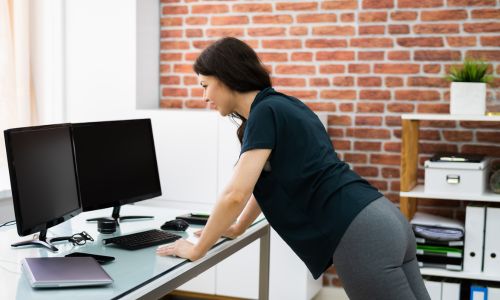
Clench your buttocks and hold for ten seconds. Do five sets of eight reps. The beauty of this exercise is that you aren't getting up and no one knows that you are secretly fitting in a workout.
Many arm exercises can be performed while seated at your desk. Stretch the muscles in your right arm by reaching as far to the left as you can with your right arm, while supporting it in the crook of your left elbow and then hold it there. Feel the stretch for five seconds. Do eight reps before switching over to your left arm.

Strengthen your core by rotating at the waist while remaining seated. Rotate as far to the left as you can and hold for five seconds, then repeat on the right. Complete five sets. Grab the backrest of your chair with your hands for support.
Move to the edge of your seat and lean back on the backrest. Straighten your legs and lift a few centimeters off the ground and raise your back a few centimeters off the backrest. Hold for ten seconds, you should feel a burn in your abdominal muscles. Do eight reps of 10 seconds.
Stand with your back against the wall with your feet shoulder-width apart and about two feet in front of you. Bending your knees, slide your back down the wall and hold this position.
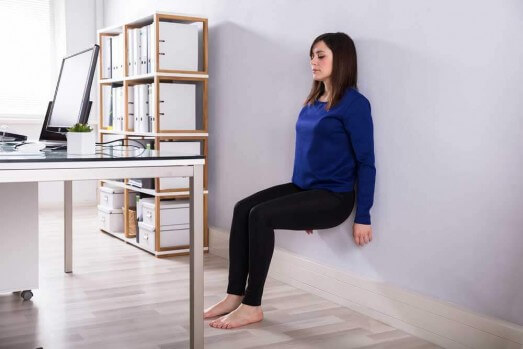
Being busy is no excuse to not exercise and stay healthy. Even if you don't have the time to exercise before or after work, there are many other ways you can incorporate movement into your daily routine. Doing regular desk exercises each day, along with getting up and walking around the office, can greatly improve health, muscle tone and strength.
With the new year upon us, now is the time to start thinking about how we can make your office more modern and contemporary in the ever-changing world of work. The future of office design is here, and we have compiled a list of five ideas to help you create an up-to-date space that will leave a lasting impression on clients and employees alike.
As technology continues to evolve at lightning speed, leveraging this in your office design is essential. This means everything from basics such as investing in high-speed internet connections and ergonomic furniture to incorporating automation into your everyday tasks. Not only will this make your office look modern, but it will also provide a boost in productivity and efficiency. More than ever before, technology is playing an integral role in how we work—from remote working capabilities to online tools that make it easier to share documents or collaborate with colleagues from other parts of the world.
When planning your office design for 2023, consider incorporating tech-friendly spaces such as dedicated charging stations where employees can charge their devices or breakout areas with built-in projectors where employees can easily connect their laptops or tablets with ease. Having these tech-friendly spaces available will make it easier for your team to stay connected no matter their location and keep your organisation on the cutting edge.
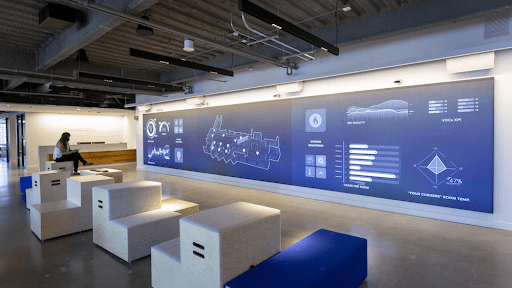
Open spaces are becoming increasingly popular as they provide more opportunities for collaboration and create an environment that encourages creativity. Consider adding low partitions or glass walls instead of solid walls to create an open feel without sacrificing privacy or soundproofing. Additionally, be sure to incorporate plenty of comfortable seating options into the design so that employees can work together easily in their shared space. Open floor plans also provide natural light which helps create a more comfortable working environment and enhances morale among staff members. If your current office setup doesn't have enough natural light, consider adding some light fixtures or big windows to bring in more brightness throughout the day.
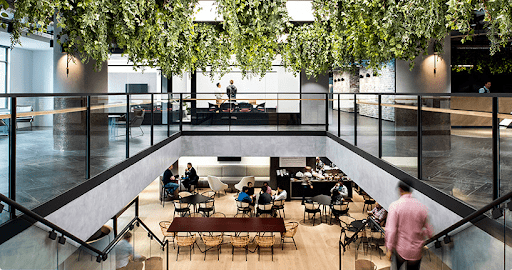
Incorporating natural elements into your office design has been linked with improved productivity and mental well-being among employees. Adding plants or using natural materials such as wood or stone can help brighten up the space while providing a calming atmosphere. Additionally, consider installing skylights or windows to let in more natural light – studies have shown that natural lighting can reduce stress levels and increase productivity. Biophilic design elements such as plants, water features, or living walls can help create a calming atmosphere in any workspace while providing numerous physiological benefits such as improved concentration and creativity. Biophilic design elements can also help reduce stress levels among employees by connecting them with nature while they're indoors. Incorporating these elements into your office design can have a positive effect on both productivity and mental well-being at work.
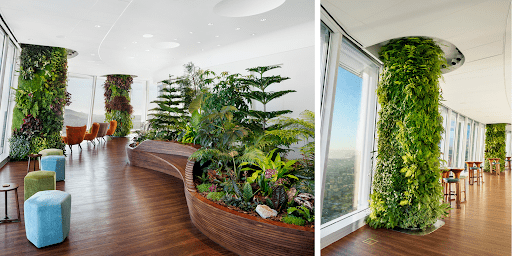
Colour plays an important role in setting the tone of a space, so carefully consider which colour palette best suits your brand’s identity before making any decisions about paint colours or furniture fabrics. Colours have been proven to affect emotions and behaviour, so it’s important to choose the right shades to encourage productivity rather than distract from it! For example, blue hues are thought to promote focus while green evokes feelings of relaxation and calmness.
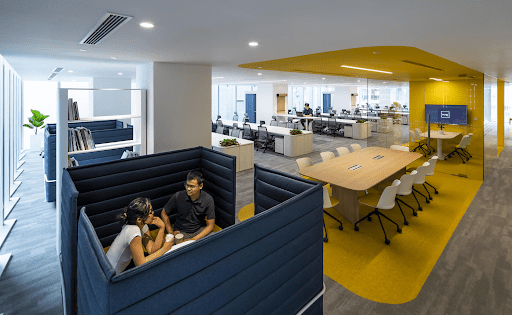
Finally, don’t forget about personalisation when designing your office space! Adding personal touches such as framed artwork or photos can help create a sense of belonging among employees while simultaneously giving visitors a warm welcome as soon as they enter the room. Don’t be afraid to get creative – this could mean anything from hanging wall art featuring local artists or installing bean bags for impromptu meetings. The line between home and work is very blurred now and workers want to feel at home within their workspace; this helps make them feel relaxed and is bound to bring out the best in them.
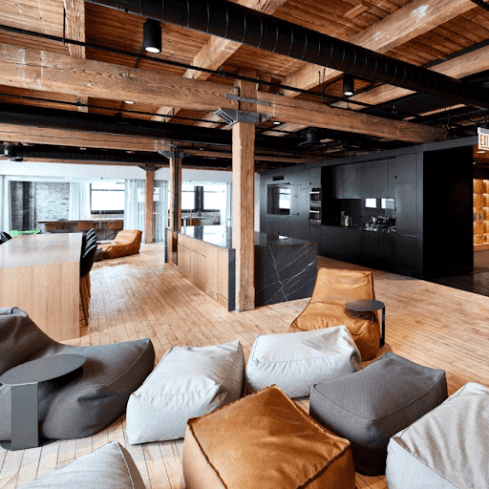
So there you have it. 2023 is the year that you can be well on your way to creating a modern workspace that will not only impress clients but also keep employees engaged and productive. Investing time into updating your office design now will pay off dividends down the line; start planning today! If you need some inspiration, head to modernoffice.co.nz or contact us today, we’d love to chat!
Many organisations are adopting hybrid working now, but what does it actually mean?
According to the Cambridge Dictionary, hybrid working is “a way of working that combines time spent in an office with time spent working from home, typically using technology such as the internet and email to stay in touch with colleagues.” In other words, it’s a mix of traditional office work and remote work which is more the norm these days.
During the pandemic, many organisations adopted hybrid work models out of necessity. However, there are many benefits to hybrid working that make it worth considering as a long-term solution for your business if it isn’t already. For example, hybrid working can lead to increased productivity, improved work/life balance for employees, and reduced overhead costs for businesses. To do it successfully and support staff members, understand expectations on both sides so there’s no ambiguity, keep a focus on well-being and create an office environment that supports productive work when employees are in the office.

Here are some ways that hybrid working can be supported with your office furniture choices:
When employees are splitting their time between the office and home, it’s important to consider ergonomics. After all, they’ll need to be comfortable whether they’re sitting at a desk or working at a kitchen table. Look for furniture that is adjustable so that employees can find the perfect position for their bodies regardless of where they’re working. For example, adjustable-height desks are a great option because they can be used as both sit-down desks and standing desks.
If you’ve ever worked from home, you know that one of the challenges is finding a place for all your stuff. When you’re only in the office part-time, you can’t just leave everything out on your desk—you need to be able to pack it up and take it with you when you head home for the day. That’s why it’s important to get creative with storage solutions when furnishing a hybrid workplace. For example, you could get mobile storage cabinets that fit under your desk so that you can easily access your files whether you’re in the office or at home. Or if you don’t need physical files, consider getting each employee a laptop safe or locker where they can store their laptop and belongings when they’re not in use.

Another important consideration when furnishing a hybrid workplace is seating. Keep in mind that not everyone will want to sit at a desk all day—some people may prefer to work from couches or chairs instead. So make sure there is plenty of varied seating in your office so that everyone can find a spot that suits their needs. And if possible, try to get furniture that is portable so that employees can move it around as needed throughout the day. For example, beanbag chairs or ottomans are a great option because they can be easily moved and reconfigured as needed. Or if people don’t want to sit at all, consider height-adjustable desks which are small enough to fit in home offices.

Soundbox silence booths are a versatile solution to offer quiet spaces within busy open-plan offices. They provide sound insulation for privacy and meetings, and also offer alternative workspaces for focused tasks, without the need for additional meeting rooms.
Another option is acoustic screens, which are spatial and acoustic partitions that fall elegantly from the ceiling to the floor. Lightweight yet sturdy, acoustic screens are semi-permanent by nature; easy to install, uninstall, and move around your space as require plus add colour that can perfectly harmonise with your brand.

The benefits of hybrid working are numerous—for both employees and employers alike—which is why more and more organisations are considering implementing this type of work model moving forward. If you're thinking of doing so in your own organisation, there are some things you'll need to take into account—namely how you're going to furnish your office space to support this type of work model.
By considering ergonomics, getting creative with storage solutions, and ensuring there's enough seating (just to name a few), you can set your team up for success in their new hybrid workplace! Ask the team at Modern Office how to get started in your organisation today.
The term biophilic is becoming a lot more popular when describing workspaces these days, and there are a number of reasons that this design movement is gaining momentum.
But what exactly is it and why should the modern workplace consider biophilic elements in their design? Biophilic design is defined as a concept used within the building industry to increase occupant connectivity to the natural environment through the use of direct nature, indirect nature, and space and place conditions. As more people return to the workplace, we are seeing how significant biophilic elements can be. Employers are keen to explore and upgrade the office environment for their people so they are just as comfortable at work as they have been at home. This is bringing forth a new norm and creating a post-pandemic standard that integrates biophilia amongst other things, within the workplace.
But biophilia is more than just an aesthetic philosophy—biophilic design has been found to support cognitive function, physical health, and psychological well-being. The concept of incorporating biophilic design into offices is to encourage the connection between humans and nature, as well as promote staff wellness and productivity.
Today more so than ever, employees need places and spaces to connect, engage, and identify with. To embrace biophilic design, we need to reimagine how we engage with and operate in the workplace, promote learning and collaboration, while placing employee health and wellness at the forefront of the design.
Implementing biophilic design doesn’t have to be a major undertaking. Guided by social ecologist Stephen Kellert’s 6 principles, any organisation could start by making minimal changes to a space, which on its own could impact the environment and users positively.
These biophilic design principles include:
• Environmental features
• Light and space
• Natural shapes and forms
• Natural patterns and processes
• Place-based relationships
• Evolved human-nature relationships
A good place to start incorporating biophilia in the workplace is to embrace the first three principles. Adding greenery, making better use of daylight, utilising natural ventilation, and adding water features within a space can help bring some of nature’s key elements into the office.
The Modern Office team recently attended Worktech, and one of the inspiring examples of biophilia in the workplace was from law firm Meredith Connell, who created a life-sized terrarium for their Auckland office.
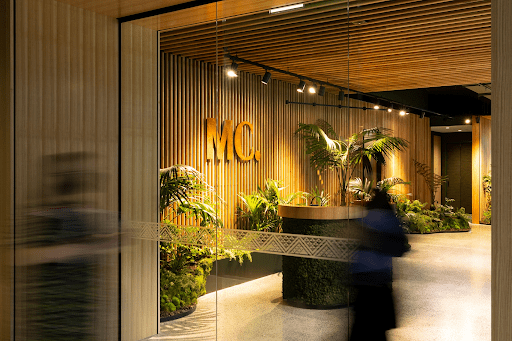
A large portion of MC’s staff are Generation Z, so creating an environment that appealed to this age group was a key driver in their decision making. They maximised the social aspects of workspaces by creating a lunchroom/staff area for their team to socialise and collaborate in, with soft seating to relax in.
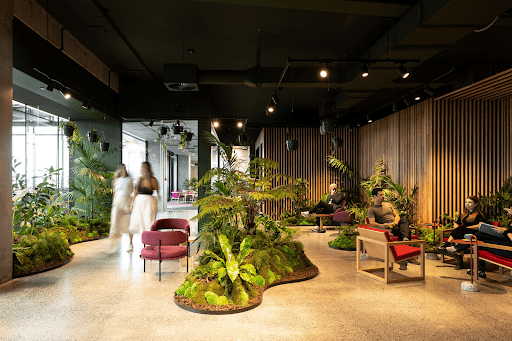
If you’re considering refreshing your environment, here are our tips on simple ways to incorporate biophilic elements into your workplace:
• Expose yourself to plants indoors. These planters and plant walls can quickly add greenery to corporate spaces.
• Let natural light in wherever possible, or get outside and experience it during the day.
• Listen to nature sounds.
• Use natural shapes and forms in your furniture choices. Our Mello sofa or chair options like Ava introduce softness and curves to spaces that traditionally have harsh straight lines.
• Bring people together. Create a space within your office that encourages human contact and collaboration. Employees crave this especially after the pandemic, and they want spaces that are reminiscent of their homes where friends congregate.
If you would like some advice on refreshing your workspace for renewed energy this spring, get in touch with our team today.
As a professional, you want to ensure maximum productivity in your workspace, but have you ever considered the impact of your office's organisation on your or your team’s productivity? Workplace organisation encompasses much more than just the physical arrangement of desks and chairs; it refers to streamlining processes, resources, and tasks in a way that reduces clutter, promotes optimal workflow, and ultimately boosts productivity. In this blog, we'll explore the critical role of organised office spaces in enhancing productivity in your business.
A cluttered workspace, with piles of papers and multiple tasks competing for our attention, can be overwhelming and sap our mental energy. By adopting an organised approach to your workspace, you streamline your work processes, freeing up your mental space, which translates to increased productivity. Additionally, an organised office environment helps reduce distractions and allows employees to focus their attention on the task at hand.
An organized workplace promotes a systematic approach to work processes, making it easier to identify and eliminate inefficiencies. By decluttering, prioritising tasks and processes, and streamlining workflows, time-consuming or redundant processes are eliminated, resulting in lower operational costs and improved productivity.
A cluttered workspace poses an unnecessary risk to your employees' health and safety. An organised office environment is vital to minimise the incidence of work-related injuries such as trips or falls, as well as other health hazards such as exposure to dust or chemicals. Implementing an organised office space also minimises stress levels, which can lead to improved overall health in the workplace.
An organised workspace not only makes it easier for employees to work, but it also improves the professional image of your business. An cluttered and unorganised workspace can leave visitors with a negative impression of your organisation. An organised workspace, on the other hand, presents an environment that portrays professionalism and a commitment to quality.
A clean and organised workspace can boost employees' morale and job satisfaction levels. When employees have a sense of order and control over their workspace, they are more motivated to work productively. Additionally, an organised workspace encourages a positive team culture where employees can thrive and excel in their roles.
So now that you know the benefits, how do you go about keeping your space more organised?
Effective storage is the obvious way to keep clutter out of sight. Here at Modern Office, we’ve got a range of storage options from mobiles to tambours to cupboards, in any look that your office needs. If your organisation embraces hot-desking, then consider lockers for safekeeping your team’s items as well.
Our range of desk partitions are also a way to minimise mess and keep your work area looking tidy and professional. Additionally, if you have an open plan space and need some separation, then our Cascade panels offer a colourful acoustic solution to keep areas defined and give your space a more organised feel.
An organised office space is about much more than just keeping your desk tidy. It's about creating an environment that promotes a streamlined workflow, improved efficiency, and ultimately enhanced productivity. By adopting an organised approach to your workspace, you can create a positive work culture that boosts employee morale and job satisfaction levels, resulting in increased productivity and success for your business. Modern Office can source a large range of items that can help get your workspace to work better for you and your team. Our experience in fitting out larger workspaces means that we can find a bespoke solution and design advice for your unique workspace regardless of size and budget. Get in touch with our team today!
To celebrate our 15th birthday *pause for applause*, we’ve put together 15 epic ways to refresh your workspace whether you’ve been in your office one year or several. It’s important to keep things fresh in an office environment in order to keep your employees happy and productive. Change is good and, when done with Modern Office, change can make a difference. Here’s our list:
This area is the first place that makes an impression when people enter your business. Creating a warm and stylish atmosphere here can help make visitors feel relaxed.
#1 Lunar Table: To prevent the reception desk from becoming cluttered, add a small guest table to place informative documents, leaflets, and the ever-important covid sign-in and QR codes.
#2 Jubel Chair: This stylish and comfortable chair is inviting for company guests to take a seat and means they won’t mind if your previous meeting runs over by a minute or two.
Bring your team together in a meeting room that encourages collaboration and teamwork.
#3 Harmony Chairs: This swivel chair makes movement easy and creates a flowy state that can benefit group thinking and collaboration.
#4 Meeting Table: Our Maxim Meeting Tables offer a large collective workspace for teams of up to a dozen people to join together to work on.
Work isn’t all about collaboration. Sometimes you have to focus on your own.
#5 Soundbox Booth: These acoustic booths are perfect for taking calls in a busy office or simply having a portion of quiet time for maximum productivity throughout the day.
To improve employee well-being and keep them all healthy, add ergonomic furniture to your office.
#6 Wobble Board: These keep your mind and body engaged throughout the day at your standing desk. Help subtly workout your core throughout the day, reduce fatigue and prevent back pain.
#7 Monitor Arms: Your monitor should be fixed at eye height to prevent neck pain. Place your monitor correctly with monitor arms for your double screen display.
These should be comfortable areas for spontaneous meetings.
#8 Oslo Bar Leaner: A perfect table for a breakout space. Grab a colleague and spend some time at the Oslo Bar Leaner to go over things during a busy working day.
#9 Lunar Coffee Table: Catch up with your colleague and talk through your latest projects at this snazzy coffee table made for two.
This is where the majority of office workers spend their time. Getting the right desk and chairs makes a huge impact on staff.
#10 Enhance Height Adjustable Desk: Stand or sit with an adjustable desk to keep your body feeling strong and not sore. This addition is a must.
#11 Active Task Chair: One of the many comfortable desk chairs we stock. Take a look at our collection and see which is right for your workers.
#12 Novah Pod Desk: Work in teams of two with this specially designed desk which saves space and looks great to create a workspace.
Your office says a lot about your identity and brand. Create an executive space that benefits you.
#13 Maxim Executive Desk: This incredible large desk will fit multiple screens, paperwork and files in your private office space. Coming with a matching side cabinet it’s a perfect addition to benefit your job.
#14 Munro Sofa: There needs to be a space for guests in your office for those meetings that aren’t as important as being 1-on-1 across the desk. Add a comfortable sofa to your room for more relaxing times.
Our wide range of designer office storage systems are a necessary addition to stop your office from looking cluttered and unkempt.
#15 Oslo Credenza: Available in multiple sizes, these storage units can stock all your stationery, files, records and more.
This is just a flavour of the products we can help bring into your office space to enhance how you and your team works. We tailor our offering to each client, so sizes, colours and configurations are all unique and perfect for you. Get in touch today for a no-obligation consultation to discuss your specific requirements!
In today's fast-paced and competitive work environment, employers are looking for ways to improve employee productivity and well-being, and this is becoming a factor that influences employees’ decisions on who to work for. One of the most effective ways to achieve this is by incorporating wellness trends into the workplace. By promoting physical activity, healthy eating, and mental health management, employers can create an environment that encourages wellness and promotes a better quality of life for their employees. In this blog post, we will explore some of the latest wellness trends in the workplace and how your furniture can adapt to support them.
But firstly, what is a wellness room and why would anyone want or need them?
Wellness rooms are spaces where employees can rest, relax and re-energise. Sometimes this includes exercise, meditation, a private space for mothers or just quiet spaces with biophilic elements so staff members can relax and have some time out. Studies have shown that employees with higher levels of wellbeing are more productive and loyal, so its often in employers’ best interest to create options where this is possible.
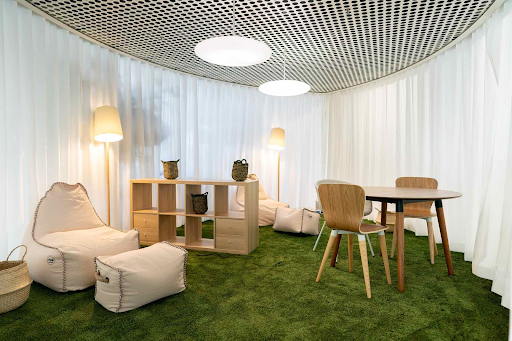
There are some furniture elements that can contribute to creating the perfect wellness space in your office. Consider the following for a wellness space that you might want to create:
Ergonomic furniture is designed to improve posture and reduce strain on the body. This type of furniture is especially important for employees who sit at a desk for extended periods. Ergonomic chairs and desks can be height-adjustable to accommodate the individual needs of employees and help prevent common health issues associated with sitting for long periods.
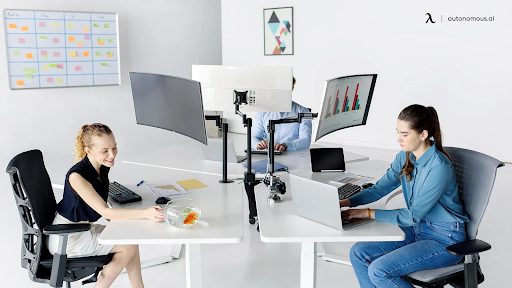
Studies have shown that sitting for long periods is not good for our health. Sitting for long hours can lead to obesity, diabetes, high blood pressure, and other health problems. Sit-stand desks allow employees to alternate between sitting and standing while working, which can help reduce the risk of these health problems. Height adjustable desks such as the Enhance pods are adjustable, allowing employees to switch back and forth between positions as needed throughout the day.
Spending time in nature has been shown to improve our mental health. Outdoor office furniture, such as picnic tables or benches, provides a way for employees to spend time outside during their breaks. A nature break can provide much needed Vitamin D, help reduce stress, boost creative thinking, and promote a better mood.

Comfortable soft seating allows wellness rooms to be more homely and welcoming, for a place to relax and refocus. This type of seating also offers pops of colour to brighten up or calm a room down.
Collaborative spaces are an excellent way to promote teamwork and communication among employees. These spaces can be outfitted with comfortable, modular furniture that is flexible and easy to rearrange. Collaborative spaces can also include whiteboards, display screens, and other technology that supports group meetings and presentations.
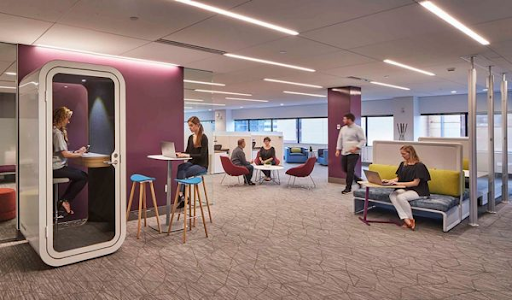
Lighter furniture materials, such as mesh and aluminium, are becoming increasingly popular in office furniture design. These materials are not only lightweight but also easier to clean and maintain. They are also more environmentally friendly as they use fewer resources to produce and transport.
There are many ways that employers can improve workplace wellness, and incorporating wellness trends into office furniture is a great place to start. With the right spaces, you can create a work environment that promotes physical activity, healthy eating, and mental health management. Not only will this improve employee well-being and productivity, but it will also benefit your business by reducing healthcare costs and employee turnover. So, if you want to create a healthier and happier workplace, start by making simple changes to your office furniture. Talk to our team today about how simple furniture changes can make a difference to your team’s wellbeing.
If you need help to spruce up your office furniture, see our range and get in touch with our team for advice.
A breakout space is an area in an office where employees can go to take a break from their workstations. These spaces are usually furnished with comfortable chairs, couches, or bean bag chairs, and may include features such as TVs, video games, and books. While some people may see breakout spaces as frivolous distractions, there are actually a number of benefits to having one in your office.
Recognising that our collective physical and mental well-being was being tested during the recent crisis, many companies have worked to increase wellness offerings. They’re highlighting existing benefits that may have been overlooked, investing in new programs, and communicating consistently about them. Helping staff to live a healthy lifestyle is always a wise investment. This elevated investment in wellness resources can help as we transition back to our regular routines and beyond. More organisations are supportive of fitness areas, flexible hours to spend time with family and healthy eating programs like a fruit bowl in the office. And from a personal level, encouraging colleagues to utilize wellness offerings creates better all-round workplace relationships with your co-workers.
Employees who use breakout spaces are also more likely to be creative and collaborate with their coworkers. The same Steelcase study found that employees who had access to a breakout space were four times more likely to say they were able to do their best thinking at work. They were also three times more likely to say they were able to collaborate effectively with their coworkers. Breakout spaces are useful for informal chats and casual meetings without the pressure of booking meeting rooms or formalities.
A study by the University of Queensland found that employees who used breakout spaces reported lower levels of stress than those who didn't. This is likely due to the fact that breakout spaces provide employees with a chance to take a break from their work and clear their heads for a few minutes. When employees are less stressed, they're more productive and better able to handle challenging tasks.
If you're on the fence about whether or not to add a breakout space to your office, consider the many benefits it can provide. From improved employee morale to increased creativity and collaboration, there are plenty of good reasons to create a space where your team can relax and recharge during the workday. Browse our range of breakout or collaboration furniture and contact our team today if you’d like to discuss your space.
For many organisations, the reception area is the first one they see. Thoughtful and considered design of a reception/communal area can ensure a positive first impression and an inviting visual introduction to the organisation. A well-designed reception/communal area can also be an uplifting and inspiring space for staff. The selection of colours, furniture and layout present the overall brand to truly enhance this important space.

This is the area that reveals you as an organisation, your company values and culture. Your branding should be kept consistent throughout this space with your logo clearly visible. Colours are a key component when enhancing a reception area and play a major role in how your work environment is perceived. Whether you want to create a bold statement or use more subtle accents, colour can be used creatively to bring a space to life and convey brand messages so weave these in where you can with custom accents and furniture pieces.

Provide a space for people to gather. A reception or communal area should function as an area for people to relax, wait and work, so it is important to provide adequate space and furniture with a variety of seating options: a combination of cluster seating and more private seating options would create an ideal balance. Since this area often attracts a high volume of traffic throughout the day, prioritise durable and high-quality fittings that will stand the test of time. Consider acoustics as the flow of traffic throughout this space during a day will influence noise levels. A design scheme that utilises soft furnishing and sound-absorbing materials such as acoustic panels or art will help maintain a more comfortable environment for privacy and to minimise echo.
Make this space comfortable and relaxing and provide a positive experience through well-planned design. Strike a good balance between comfort and sophistication, and incorporate furnishings and decorations that put guests at ease. Seating and soft furnishings can help prioritise comfort for your visitors. Lighting is also a significant design aspect and can truly enhance any space when used effectively. In addition, other decorative items such as artwork, rugs, coffee tables and indoor plants or even candles can add the special touches that elevate an area to amplify the cosiness.

The key to successful reception design is to always consider the core focus and purpose of the environment - accommodating the people who will use the space. Many of the people who use the reception will be first-time visitors, so design a space that is clear and easy to navigate. Incorporate signage to create a natural flow to guide visitors to where they need to go. The focal point of every reception area is the reception desk itself. Ensure that it is clear where guests need to go upon arrival by positioning an easy to find desk where they can be greeted. The desk should provide adequate space for receptionists to efficiently complete their work and provide space to organize paperwork and other items. The reception area does not need to be mundane, it is the hub of the company and can be a great opportunity to creatively introduce your story to visitors.

Today’s reception/communal area accommodates modern technology and provides a user-friendly experience for both staff and visitors. Connectivity is considered an essential feature of modern spatial design and integrated power within furniture is becoming more commonplace. Free wifi access allows visitors to optimize their waiting time and is an expectation. As well as big screens, many modern workplaces have implemented technology such as iPads in their lobbies so that guests can sign themselves in and staff members will be notified digitally as they arrive. Reception areas are the face of any company and when designing a fit-out, this space should be carefully considered to achieve an environment that accommodates visitors' needs whilst reflecting the ethos of the organisation in a positive way.
For advice or ideas on enhancing your reception or communal area, contact the Modern Office team for a no-obligation consultation today.
We invite you to take a look at our project inspiration page as it will give you some bright ideas and show you just how spectacular our office fit-outs are. You’ll notice plenty of stunning designer office furniture, of course, as well as layouts that optimise the available space, maximise productivity, and help to create a harmonious working environment.
Something else you'll notice when you look at our past projects is the extensive use of height-adjustable desks. This is quite deliberate. We see height-adjustable desks as a must-have in today’s modern office for reasons of comfort, well-being, and productivity. Ask any physio, and they’ll tell you that muscle strain, back injury, and other painful issues, as well as poor posture, are common when an employee sits at their desk for too long. They’re often hunched over their keyboard, which is not good for their spinal and neck posture, and their general health suffers too.

While physio treatments will relieve pain – albeit temporarily – prevention is always better than the cure. That is why we recommend that you put height-adjustable desks on your shopping list when it’s time to buy office furniture in NZ. These desks let your employees do their work while they’re standing, with the option of sitting from time to time. The major health benefits of working with height-adjustable desks include delaying the onset of fatigue later in the day, reducing lower back pain, preventing tight hips which can lead to lower back pain, lowering the risk of putting on weight and improving cardiovascular health as a result, and helping to keep the mind alert – yet another productivity booster.

In summary, a desk that is height-adjustable is a healthier desk. Research has proven that the general well-being of employees is enhanced when they complete their tasks while standing. They are less likely to gain weight and their heart health improves. Because they’re physically fitter, team members are mentally sharper as well, so they are not as fatigued and their thinking is clearer. Back and neck pain is far less of an issue, which means fewer days off seeking medical treatment, and their posture is improved - and this is another crucial element in promoting general health.
There is every reason to invest in height-adjustable desks, and no reason not to. For higher productivity and staff morale, we suggest you put them on your office furniture shopping list and then contact us.
Workspace plays an important role in the successful development and growth of any business. When it comes to designing or refitting your office, you need to create layout solutions that can adapt and transform easily to meet the changing needs of the business and future-proof your office.
Over the last few years, design trends have been about flexible, open, and collaborative spaces. Designers claim that these multi-use offices lead to better communication and diminish hierarchy within the office. The problem with this type of layout is that not enough thought has gone into issues that arise with noise, creating zones, visual aesthetics, and the impact on staff well-being.
A study done by the University of Massachusetts found that adding colour to your office can help employees, as it reduces stress, increases creativity, enhances morale, broadens their appreciation of diversity, and encourages discussions and expressions of opinions. What the eyes can see can either have a positive or negative effect on a person’s brain activity, so adding a bit of colour and texture to your office can benefit your employees.
A simple way to add colour to your space is through the use of decorative screens or wall tiles. With many different colours, textures, and designs available, these can have the effect of an office mini makeover, offering your staff something visually stimulating to look at instead of rows of desks and chairs.
Specific hues also improve certain brain functions that can help boost productivity at work, so perhaps choose screen colours based on the type of activity that is occurring in each space, e.g., yellow to enhance clarity and precision.
As office sizes expand, you may want to look at separating your open plan design into zones. Some designers have started referring to these organisational units as ‘neighbourhoods’ and advocate for decorating them distinctly, to help workers, or visiting clients, get a sense of where everyone is within the office. Using screens and partitions are a great way to section the office and bring order to chaos. They create spaces that make sense for specific tasks without blocking light or visually upsetting the open-plan feel.
Quiet zones are designed for tasks that demand heightened focus in an office. Acoustic screens or wall tiles are a flexible way of ensuring acoustic comfort and privacy in these zones. Created to mitigate the privacy and noise pollution concerns of open-planning, acoustic partitions provide improved speech clarity, maintain confidentiality, and help improve concentration levels.
As a business, first impressions are important and your office design can have a big impact on how your clients and guests perceive your brand. As your reception is usually the first space your customers see, it is important that this area, in particular, makes a positive impact. Coloured and textured decorative screens are a great way to modernise your reception area and add a bit of character. Autex Cascade hanging screens are a stylish and forward-thinking solution to create privacy and can be a great way to screen off the reception area from the hustle and bustle of the main office.
Overall, your office communicates the nature of your business in both subtle and obvious ways. Much of the message your office sends can be refined through smart office design. Screens, partitions, and wall tiles are just one way you can modernise your space. Get in touch with one of our friendly team for some more ideas.
Want to work smarter, not harder? Learn how to optimise your desk setup for maximum productivity and motivation throughout the workday.
Invest in a Height-Adjustable Desk
Our bodies aren't designed to sit for long periods, which is why many businesses are investing in height-adjustable desks. Experts recommend standing for at least half the day, as it offers numerous health benefits and can be a selling point when recruiting new employees. Research indicates that alternating between sitting and standing can improve posture, reduce the risk of chronic diseases, and enhance mental alertness.
Choosing the Right Desk
There are two main types of height-adjustable desks: manual and electric desks. Manual desks are cost-effective and simple to use, while electric desks offer ease of adjustment with the push of a button. Consider your budget and preferences when choosing the right desk for your needs.
Add a Floor Mat
Standing for extended periods can cause discomfort, so consider adding an anti-fatigue floor mat. These mats provide cushioning, reduce pressure on your feet and legs, and promote subtle movements that can improve circulation and reduce fatigue.
Maximise Natural Light Exposure
Ensure your desk is near a window to maximise natural light exposure. Natural light has been shown to improve sleep quality, reduce headaches and eye strain, and minimise errors. If natural light isn't available, consider using a light therapy lamp to simulate daylight and maintain your circadian rhythm.
Optimise Your Desk Accessories
Properly setting up accessories like your keyboard, mouse, and monitor can prevent injuries and maintain an ergonomic posture. Here are some tips:
Keyboard and Mouse
Position: Keep your keyboard and mouse close enough to prevent reaching. Your elbows should be at a 90-degree angle, and your wrists should be in a neutral position.
Ergonomic Options: Consider using an ergonomic keyboard and mouse to reduce strain on your wrists and hands.
Monitor Placement
Height: Position your monitor so that the top of the screen is at or just below eye level. This prevents neck strain and promotes a natural head position.
Distance: Place the monitor about an arm's length away from your eyes to reduce eye strain.
Keep Your Workspace Clutter-Free
A cluttered workspace can be distracting and hinder productivity. Keep your desk organised and free of unnecessary items. Use storage solutions like drawers, shelves, and desk organisers to keep everything in its place. A clean and organised workspace can help you stay focused and efficient.
Personalise Your Space
Personalising your workspace can make it more enjoyable and boost your creativity. Here are some ideas:
Add Plants
Plants not only add vibrancy to your workspace but also enhance creativity, reduce stress, and purify the air. Choose low-maintenance plants like succulents, snake plants, or pothos to add a touch of greenery to your desk.
Decorate with Meaningful Items
Decorate your desk with items that inspire you or hold sentimental value. This could be photos, artwork, or motivational quotes. Personal touches can make your workspace feel more inviting and boost your mood.
Take Regular Breaks
Taking regular breaks is essential for maintaining productivity and overall well-being. Short breaks can help you recharge, reduce mental fatigue, and prevent burnout. Try the Pomodoro Technique, which involves working for 25 minutes and then taking a 5-minute break. After four work sessions, take a longer break of 15-30 minutes.
Consult with Experts
If you're looking to revamp your office space for increased productivity or need advice on desk setups for your staff, contact our team for a consultation. Our experts can help you create an ergonomic and productive workspace tailored to your needs.
By investing in ergonomic furniture, optimising your desk setup, and incorporating personal touches, you can create a workspace that boosts productivity and enhances your overall well-being. Start making these changes today and experience the benefits of a well-designed workspace.
We're in the business of inspiration. Collaborating with architects and designers allows us to work on a wide range of projects, creating offices that benefit and inspire your staff. As an office fit-out specialist, we're equipped to assist with office furniture and design, offering access to a wide array of brands and being the sole distributor of Nurus commercial furniture in New Zealand.
So, how does partnering with us for your new office design work?
Step 1:
The first step is to understand your goals. How does your business operate? What industry are you in? What are your staff's working preferences? Based on this brief, we'll tailor a personalised plan to suit your long-term needs.
Step 2:
An expertly designed floor plan is essential. Our fit-out service includes this step. We translate practical needs for the space into a furniture plan that meets all requirements, using software to create scaled drawings for an accurate visualisation of the proposed office layout.
Step 3:
Working closely with the designer or architect, we discuss business needs and individual tastes to combine our expertise in office furniture and color specification. Brand representation, productivity, staff happiness, and functionality are key aspects of this collaboration.
Step 4:
Our fit-out team manages the procurement, delivery, and installation of the agreed office furniture and technology. Our emphasis on speed and efficiency ensures jobs are completed sooner, making for a happier customer.
Step 5:
Providing ongoing after-sales support, we offer a post-implementation meeting to review the installation after you've had a chance to use it. Our team is dedicated to building long-term relationships and supporting future changes as required.
Get in touch with Modern Office today for expertise and support in fitting out offices. We provide personalised service and ensure availability to meet all requirements around supply and maintenance, both now and in the future.